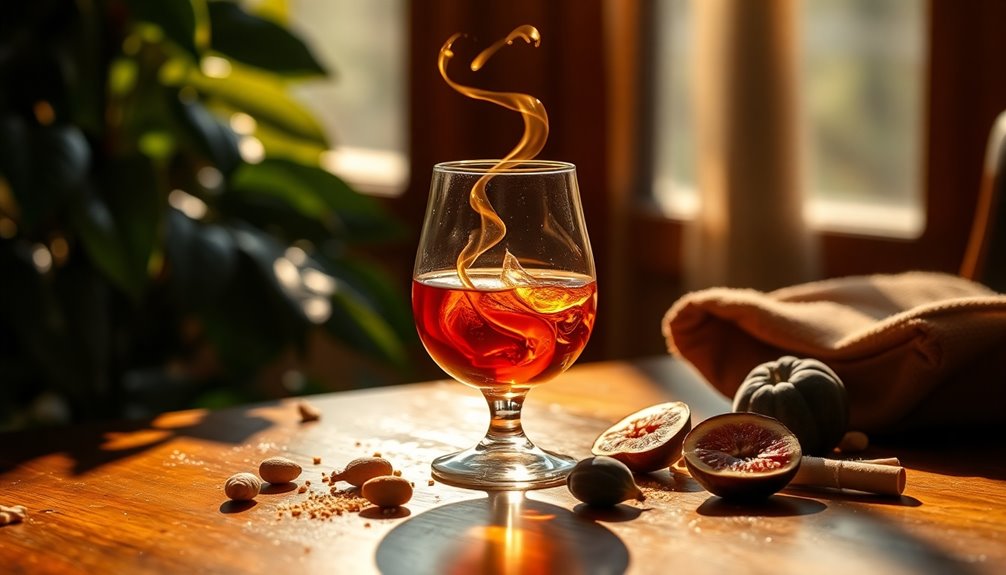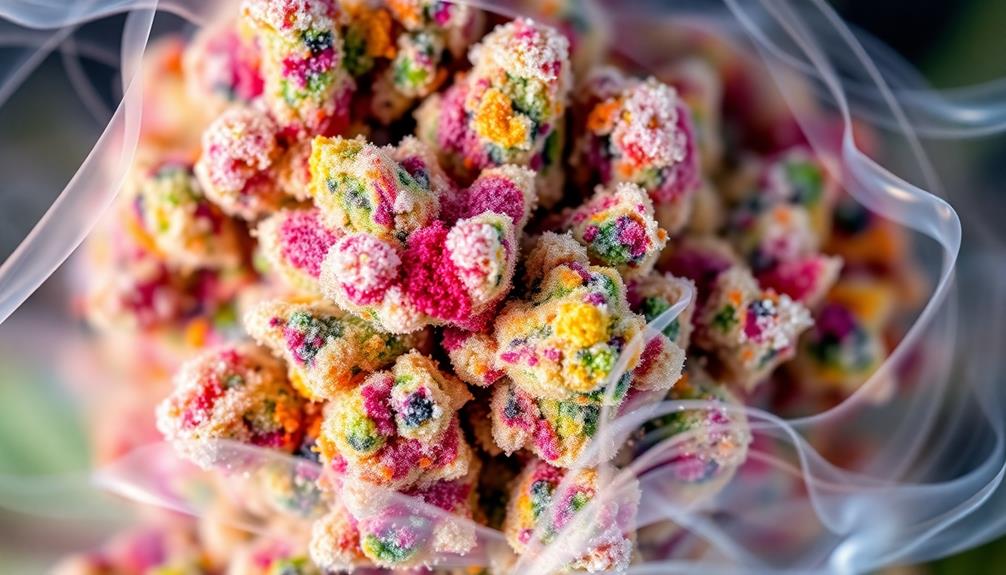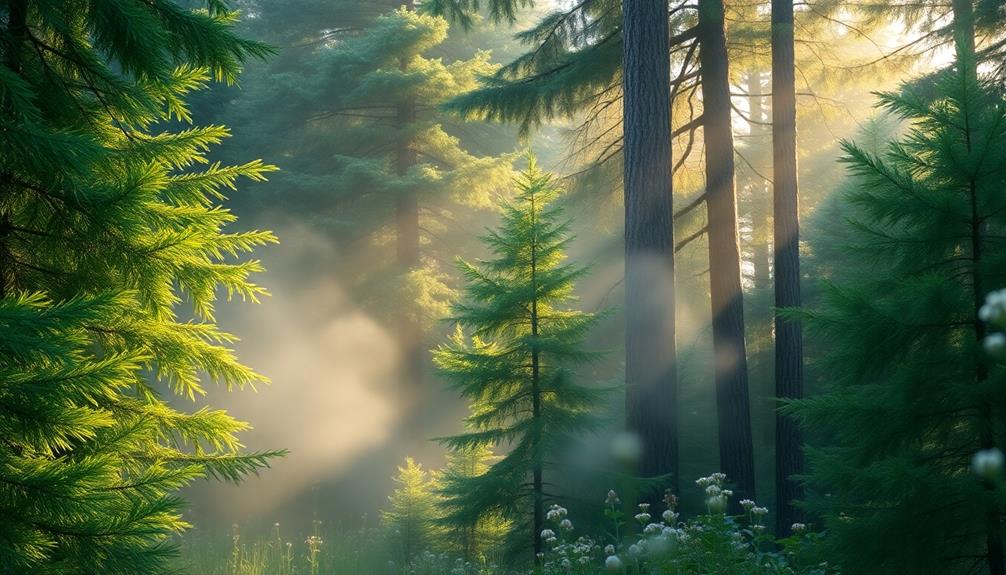When you smell cognac, you're met with a captivating blend of aromas. Younger varieties bring fresh floral notes, vanilla, and bright citrus. As cognac ages, richer scents emerge, like tobacco, leather, and cocoa, creating a warm complexity. You'll also notice hints of dried fruits and spices that contribute to its depth. This delightful bouquet is shaped by the distilled grapes and oak barrels used during aging. Whether you're in a cozy lounge or enjoying it at home, each sip reveals new layers of scent. Stick around to uncover more about the unique qualities that make cognac truly special.
Key Takeaways
- Cognac offers a complex aroma with over 36 key scents, including floral, fruity, and earthy notes.
- Younger cognacs typically feature fresh vanilla, citrus, and dried fruits, while older varieties reveal rich leather and cocoa aromas.
- Aging in oak barrels adds subtleties of sandalwood, cedar, and unique nutty scents known as rancio.
- Chemical compounds like beta-damascenone contribute to distinctive aromas such as dried fruit and butterscotch.
- The aroma evolves with time, creating intricate layers that enhance the tasting experience.
Introduction
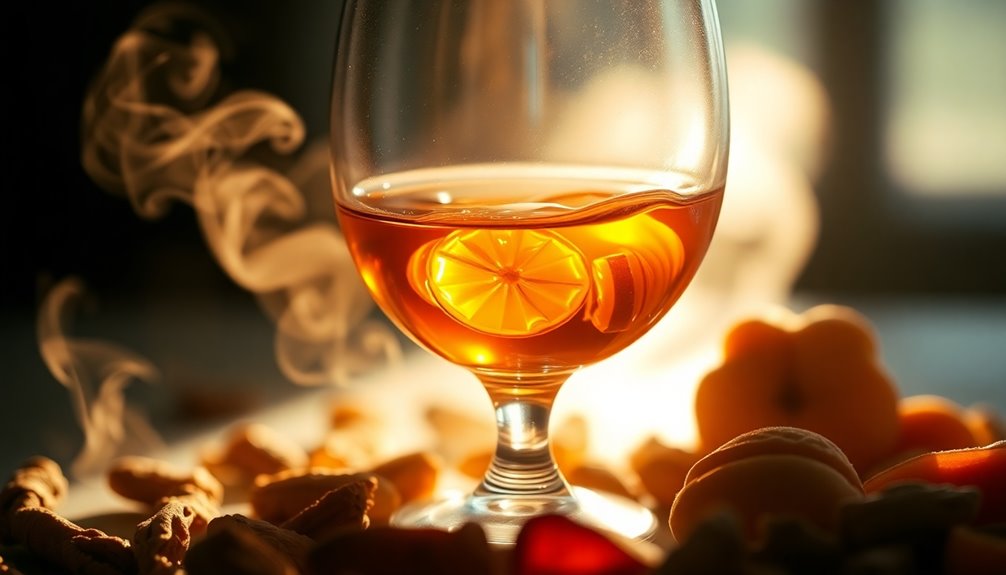
Exploring the world of cognac reveals a fascinating tapestry of aromas that capture the essence of this renowned spirit. When you take a moment to appreciate the smell of cognac, you'll quickly notice its complexity, which stems from a blend of 36 key aromas. Each sip tells a story, showcasing a wide range of scents that can transport you through time and experience.
Younger cognacs often greet you with fresh, floral notes, while older varieties unveil richer aromas like leather, cocoa, and molasses. As you delve deeper into the olfactory experience, you might catch hints of vanilla, citrus, and dried fruits, all of which dance harmoniously with more robust scents of tobacco and spices that develop through the aging process in oak barrels. Here, the wood imparts subtle undertones of sandalwood and cedar, adding further depth to the aroma.
With each cognac you encounter, you'll discover its unique personality, shaped by age and craftsmanship. From bitter chocolate to ripe cherries, the smell of cognac invites you to explore its intricate layers and appreciate the artistry behind this exquisite spirit.
Description of the Smell
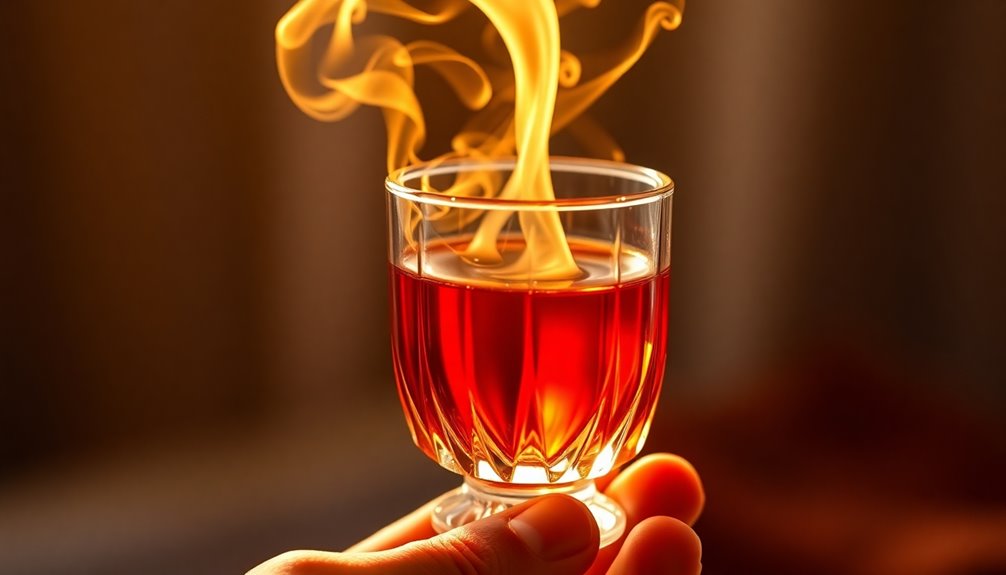
Cognac's smell is a captivating blend that offers a sensory journey through its intricate aromatic layers. As you take in the aroma, your olfactory receptors pick up on a rich palette of scents. Younger cognacs often greet you with pronounced notes of vanilla, dried fruits, caramel, and citrus, creating a delightful initial impression.
As cognac ages, its aroma evolves remarkably, introducing deeper complexities. You might notice hints of tobacco and spices, alongside a unique characteristic known as rancio, which brings forth nutty and pungent scents. This transformation showcases the fascinating principles of food chemistry at play, highlighting how the aging process enriches the aromatic profile.
Each cognac variety has its own distinct aroma. For example, Hermitage 30 Year Old may surprise you with its notes of molasses and bitter chocolate, while Hermitage 43 Year Old can evoke memories of fresh straw and grapefruit peel. The intricate interplay of these aromas makes cognac one of the most complex foodstuffs, surpassing many other beverages and foods in aromatic diversity. Experience the layers, and you'll appreciate why cognac is celebrated for its captivating scent.
Source and Composition
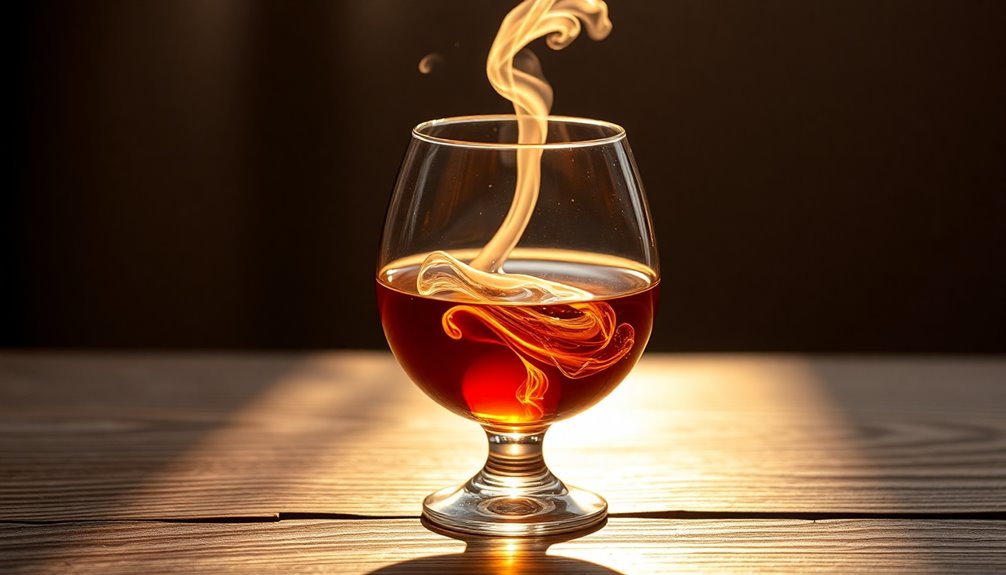
The captivating aroma of cognac originates from a combination of its ingredients and the meticulous aging process. At the heart of its complexity are 36 key molecules that contribute to the rich scent profile, making cognac one of the most intricate foodstuffs recognized. The primary sources of these captivating odours stem from distilled grapes and the oak barrels used for aging, which add layers of depth to the smell and taste.
Chemical compounds like beta-damascenone and ethyl isobutyrate are essential in creating distinctive aromas, such as dried fruit and butterscotch. As fermentation and distillation unfold, they enhance and develop the aromatic characteristics over time. You'll notice that the interaction between various odorants produces a delightful bouquet of scents—floral, fruity, and oaky—that evolve with aging, revealing deeper layers.
This intricate interplay ensures that each sip delivers a high-quality experience, where odours are translated into a captivating sensory journey. By understanding the source and composition of cognac, you'll appreciate how its aroma captivates and entices, making every tasting an exploration of its complex heritage.
Typical Scenarios or Environments
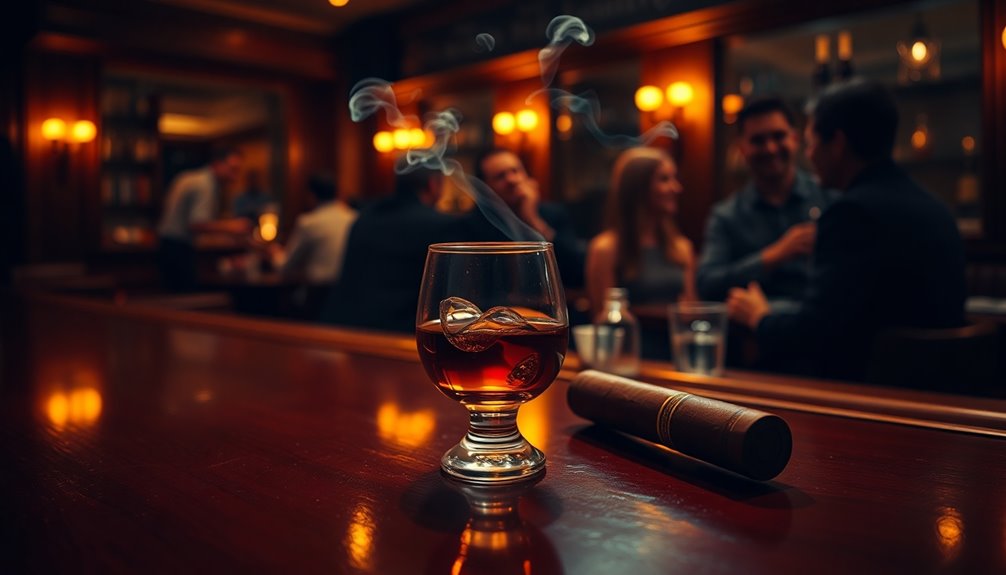
In cozy lounges or intimate homes, enjoying a glass of cognac creates a warm, inviting atmosphere that enhances its rich aromas. You'll find that the complexity of cognac's scent profile—filled with nuances like vanilla, dried fruits, and spices—makes it a perfect choice for celebratory occasions. Whether you're toasting a special moment or simply unwinding after a long day, the environment plays a crucial role in how you experience cognac.
Quiet settings allow you to savor each intricate aroma, especially during a tasting event or a sophisticated dinner with friends. The calm atmosphere helps you appreciate the subtleties that make each sip unique. Outdoor environments, particularly in cooler seasons, further elevate the experience; the crisp air highlights the warmth and depth of cognac's fragrance.
If you're in an exclusive lounge, pairing cognac with a fine cigar enhances the sensory experience even more. The mingling aromas create a rich tapestry that captivates the senses, making you appreciate the complex layers of this beloved spirit. In these typical scenarios, cognac transforms any gathering into a memorable occasion, inviting you to indulge fully.
Emotional or Cultural Associations
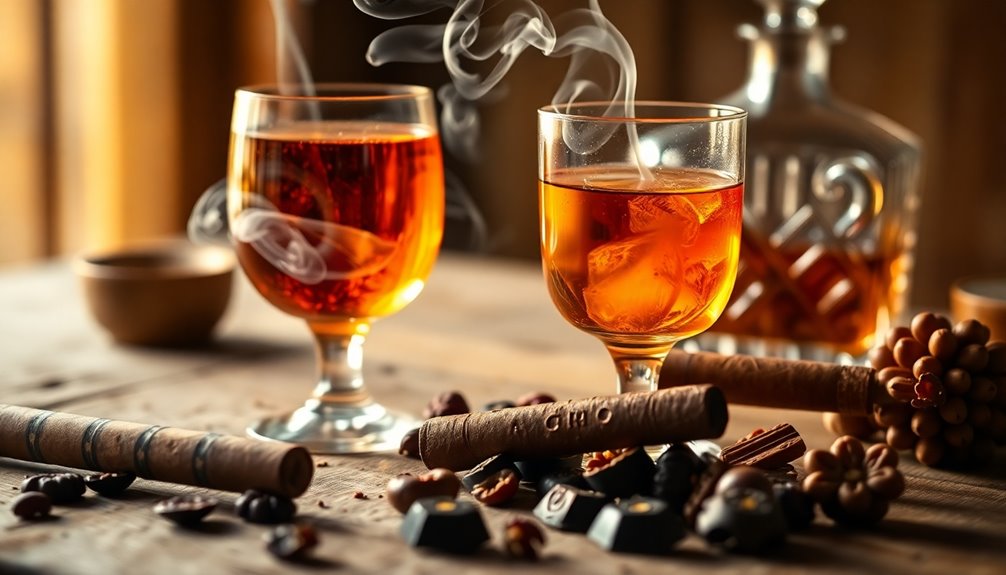
Savoring a glass of cognac often brings up feelings of warmth and luxury, creating a special ambiance during celebrations and intimate gatherings. The rich, complex aromas of cognac, with their notes of vanilla, dried fruits, and spices, evoke a sense of nostalgia and indulgence. This emotional connection is deeply rooted in the cultural significance of cognac within French history, where it symbolizes sophistication and refinement.
When you enjoy cognac, you're not just experiencing a premium spirit; you're also participating in a tradition that celebrates life's special moments. The luxurious scent enhances romantic settings, making shared experiences even more memorable. Cognac's distinct olfactory profile encourages deeper connections, whether you're toasting with friends or savoring a quiet evening with a loved one.
Marketers often emphasize these emotional and cultural associations, reinforcing cognac's status as an exclusive drink. By doing so, they cultivate an allure that makes cognac more than just a beverage; it becomes a symbol of celebration, indulgence, and shared joy. So, the next time you raise your glass, remember the rich tapestry of feelings and traditions that each sip embodies.
Health or Safety Considerations
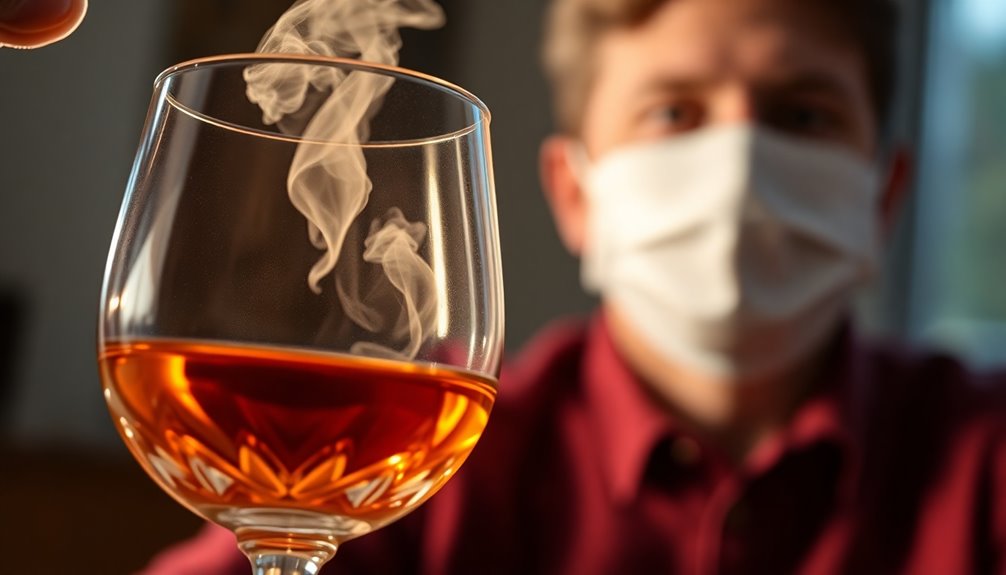
How can you enjoy cognac while keeping your health in mind? First and foremost, remember that moderation is key. Excessive alcohol intake can lead to serious health issues, including liver disease and impaired judgment. It's essential to know your limits and drink responsibly. Always adhere to local regulations regarding the legal drinking age to promote safety in your consumption habits.
Cognac contains congeners, which can contribute to hangovers and other negative health effects. By enjoying cognac in moderation, you can mitigate these risks and savor its rich flavors without adverse consequences. If you have specific health conditions, like diabetes, or are on certain medications, it's wise to consult a healthcare professional before indulging.
Lastly, ensure that your cognac is stored properly. Exposure to light and heat can degrade its quality, potentially leading to spoiled products. By taking these health and safety considerations into account, you can enjoy cognac while prioritizing your well-being. So, sip responsibly and appreciate the nuances of this exquisite spirit without compromising your health.
Final Thoughts
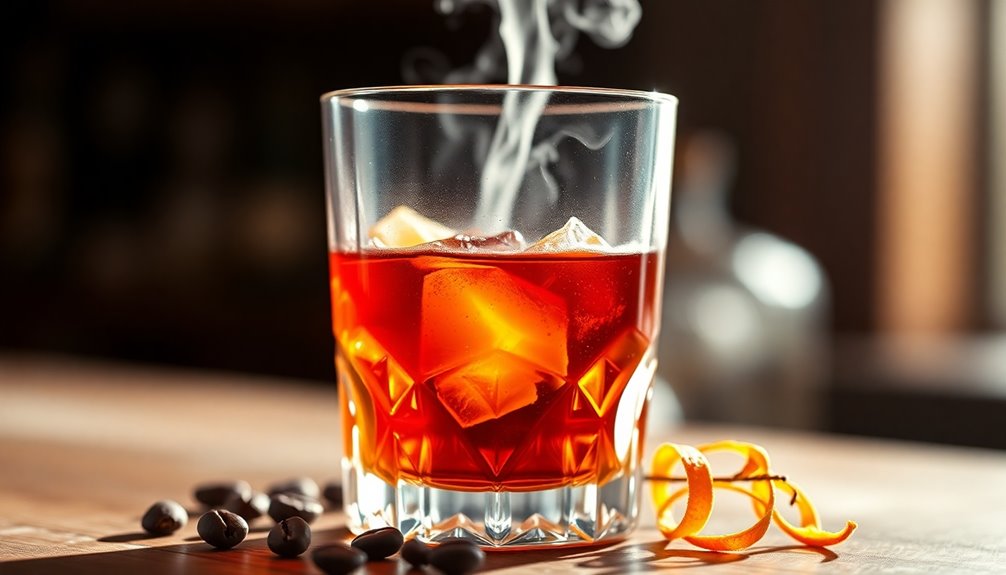
Reflecting on the intricate aromas of cognac, it's clear that this luxurious spirit offers a sensory experience like no other. The complex aroma of cognac captivates the senses, revealing an array of nuances that evolve with each sip. From the bright, floral notes of younger varieties to the deeper, richer scents found in aged versions, there's always something new to discover.
As you explore different cognacs, you'll notice the presence of 36 key odor molecules, each contributing to the intricate smell that defines this spirit. Whether it's the sweetness of vanilla, the richness of dried fruits, or the earthiness of leather and tobacco, these elements come together to create a multifaceted experience. Specific varieties, like the Hermitage 30 Year Old, surprise with their unique aromas, showcasing how diverse cognac can be.
Ultimately, the complexity of cognac's aroma enhances your appreciation and enjoyment of this exquisite beverage. It invites you to savor not just the taste but also the story behind each bottle. So, take your time, inhale deeply, and let the rich layers of cognac unfold before you.
Frequently Asked Questions
What Is Cognac Fragrance?
Cognac fragrance is a captivating blend that draws you in with its warmth and complexity. As you explore its aromas, you'll notice hints of vanilla, dried fruits, and caramel, all shaped by the aging process. You might also detect citrus notes alongside deeper elements like tobacco and spices in aged varieties. Each sip reveals a symphony of scents, making cognac a luxurious experience that stands apart from other spirits you might encounter.
What Are the Aromas of Cognac?
When exploring the aromas of cognac, you'll discover a fascinating blend of scents. You might notice sweet notes like vanilla and caramel, alongside fruity hints of orange and apricot. As you delve deeper, you may encounter richer aromas, such as tobacco and chocolate in older varieties. Each sip reveals a complex profile, influenced by aging; younger cognacs burst with bright fruitiness, while older ones offer deeper, more concentrated notes that heighten your tasting experience.
What Does Cognac Taste Like?
When you taste cognac, you'll notice a delightful complexity. Young cognacs often greet you with sweet, fruity notes, while older ones reveal layers of cocoa, leather, and spices. As you savor each sip, the aging process in oak barrels offers hints of vanilla and dried fruits. The finish lingers, balancing sweetness and bitterness, making every experience unique. Temperature and glass choice can enhance these flavors, guiding your palate through this rich journey.
What Does Hennessy Smell Like?
When you take a moment to experience Hennessy's aroma, you'll notice a rich tapestry of scents unfolding. You might detect hints of vanilla and dried fruit, accompanied by subtle floral notes. As you explore further, the complex fragrances of dark chocolate, spices, and tobacco emerge, especially in the XO variety. If you're sampling Hennessy VS, expect brighter, fruitier aromas that showcase fresh grape and citrus, creating a harmonious balance that's truly delightful.
